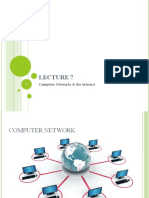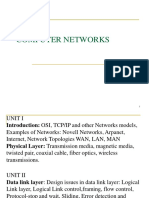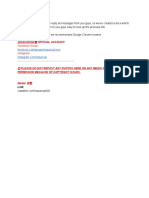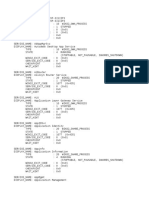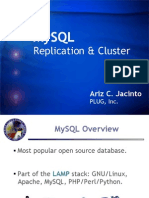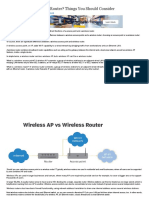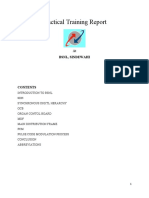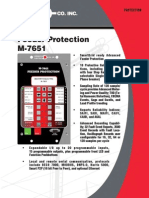Class 12 Computer Science - Chapter: Computer Networks (Part 1) As per Sumita Arora Textbook – Fully
Expanded and Elaborated Notes
✅ 1. Introduction to Computer Networks
What is a Computer Network?
A Computer Network is a system in which multiple computers and digital devices (such as printers,
scanners, routers, etc.) are linked together using communication channels to exchange data, information,
and resources.
These connections can be: - Wired (using cables like Ethernet, coaxial, or fiber-optic) - Wireless (using radio
waves, microwaves, infrared, or satellites)
Purpose:
• Facilitate resource sharing (hardware/software)
• Enable efficient communication (email, messaging, file transfer)
• Improve reliability and redundancy
• Allow remote access and management
Characteristics:
• Scalability – New nodes/devices can be added easily.
• Fault Tolerance – Backups and rerouting options in case of failure.
• Security – Authentication, encryption, and firewall controls.
• Speed – Depends on medium and technology used.
Real-World Applications:
• Hospitals (sharing patient records across departments)
• Schools (online assessments and learning platforms)
• Businesses (collaborative tools like Zoom, Google Docs)
🏢 2. Elements of a Computer Network
Hardware Components:
Element Detailed Description
A network-enabled device that sends, receives, or forwards information. Includes
Node
computers, phones, routers, IoT devices, etc.
1
� Element Detailed Description
NIC (Network An electronic hardware device that provides a computer with the ability to access
Interface Card) a network. Each NIC has a unique MAC address used for identification.
A smart device that connects multiple computers in a LAN and forwards data
Switch only to the device intended, using MAC addresses. Reduces traffic and increases
efficiency.
Unlike a switch, a hub broadcasts data to all devices on a network, regardless of
Hub
the destination. It is less intelligent and often obsolete.
A device that connects two or more networks, such as LAN to the Internet. It
Router
uses IP addresses and can assign private IPs to devices.
A device that modulates (converts digital to analog) and demodulates (analog to
Modem
digital). Essential for internet access via telephone lines or broadband.
Wireless device that allows Wi-Fi devices to connect to a wired network. Often
Access Point
integrated into routers.
Software Components:
• Network Operating System (NOS):
• Manages network resources, permissions, user accounts, and security.
• Examples: Windows Server, Linux Ubuntu Server
• Protocols:
• Set of predefined rules used for data exchange between devices.
• Examples: TCP/IP, FTP, HTTP, SMTP, etc.
🚀 3. Types of Computer Networks
3.1 PAN – Personal Area Network
• Range: Typically within 10 meters
• Devices: Smartwatches, mobile phones, wireless headsets
• Technologies: Bluetooth, Infrared, USB
• Example: Using Bluetooth to connect your phone to earbuds or smartwatch
3.2 LAN – Local Area Network
• Range: Within a limited geographic area like a home, school, or building
• Data Speed: 100 Mbps to 1 Gbps
• Setup: Switches, routers, Ethernet cables or Wi-Fi
• Examples:
2
� • Computer lab in a school
• Corporate office network
3.3 MAN – Metropolitan Area Network
• Range: Covers an entire city or a large campus
• Backbone: Fiber optics, leased lines
• Uses:
• Interconnecting university campuses
• Municipal Wi-Fi networks
3.4 WAN – Wide Area Network
• Range: Spans across countries and continents
• Technologies: Satellite communication, undersea cables
• Examples:
• Internet
• Banking networks (ATM interconnections)
🔁 4. Data Communication Process
Fundamental Elements:
1. Sender – Originator of the message (a computer, smartphone)
2. Receiver – Destination device (printer, server, another computer)
3. Message – Actual data (text, images, audio, video, files)
4. Medium – The transmission path (cables, air)
5. Protocol – A set of communication rules (TCP/IP, HTTP, FTP)
Communication Types:
• Simplex – One-way only (e.g., TV broadcast)
• Half Duplex – Both ways, one at a time (e.g., walkie-talkies)
• Full Duplex – Both ways simultaneously (e.g., phones, chat apps)
📶 5. Transmission Media
A. Wired (Guided Media)
1. Twisted Pair Cable
• Two insulated copper wires twisted to reduce electromagnetic interference
• Types:
• UTP (Unshielded Twisted Pair) – Common in LANs
3
� • STP (Shielded Twisted Pair) – For environments with more interference
• Speed: Up to 100 Mbps or more
• Distance: Short (typically less than 100m)
2. Coaxial Cable
• Central conductor, insulation, metallic shield, and outer cover
• Better resistance to noise than twisted pair
• Uses: Cable TV, older LANs
• Speed: Moderate
3. Fiber Optic Cable
• Transmits data using light pulses
• Made of glass or plastic core
• Immune to electromagnetic interference
• Speed: Extremely high (Gbps to Tbps)
• Distance: Tens of kilometers without signal loss
• Usage: Internet backbone, submarine cables
B. Wireless (Unguided Media)
1. Radio Waves
• Omnidirectional, used for long-range communication
• Examples: FM Radio, cordless phones
2. Microwaves
• Require line-of-sight
• Used in satellite and mobile networks
• High bandwidth
3. Infrared
• Short-range, line-of-sight
• Cannot penetrate walls
• Used in TV remotes, wireless mice
4. Bluetooth
• Short-range (up to 100 meters)
• Low power consumption
• Used in PANs, wearable devices, file sharing
4
�🔄 6. Switching Techniques
1. Circuit Switching
• A fixed path is established before communication begins
• Entire session uses the same route
• Advantage: Dedicated connection
• Disadvantage: Inefficient, resource wastage
• Example: Traditional landline phone call
2. Packet Switching
• Message is divided into smaller packets
• Each packet travels independently
• Advantages: Efficient, optimized bandwidth usage
• Disadvantages: Packets can arrive out of order
• Example: Internet browsing, file transfer
3. Message Switching
• Entire message is stored at intermediate devices (store-and-forward)
• No dedicated path
• High latency, but useful for emails and texts
🕸️ 7. Network Topologies
1. Bus Topology
• Single cable backbone connects all nodes
• Cost-effective for small networks
• Disadvantage: Entire network fails if backbone fails
2. Star Topology
• All nodes connect to a central hub/switch
• Easy to troubleshoot and expand
• Disadvantage: Hub failure disrupts entire network
3. Ring Topology
• Each device connected to two neighbors
• Data circulates in a circular path
• Disadvantage: Single device failure affects all
5
�4. Mesh Topology
• Every node connected to every other
• Provides high reliability and fault tolerance
• Disadvantage: Complex and costly
🔐 8. Protocols and IP Addressing
What is a Protocol?
A protocol is a set of rules and conventions that define how data is transmitted and received over a
network.
Common Protocols:
Protocol Full Form Function
HTTP HyperText Transfer Protocol Accessing web pages
Secure web communication using SSL/TLS
HTTPS Secure HTTP
encryption
Uploading and downloading files between
FTP File Transfer Protocol
computers
SMTP Simple Mail Transfer Protocol Sending email messages
POP3 Post Office Protocol v3 Receiving emails (downloads to device)
IMAP Internet Message Access Protocol Receiving emails (cloud-based access)
Transmission Control Protocol/Internet
TCP/IP Foundation of Internet communication
Protocol
IP Addressing:
• IPv4: 32-bit address divided into four 8-bit blocks (e.g., 192.168.1.1)
• IPv6: 128-bit address written in hexadecimal (e.g., 2001:0db8:85a3:0000:0000:8a2e:0370:7334)
• Static IP: Manually assigned, permanent
• Dynamic IP: Temporarily assigned by a DHCP server
✅ 9. Advantages of Computer Networks
• Faster and cheaper communication (emails, messaging, VoIP)
• Resource sharing reduces cost and redundancy
• Data centralization ensures consistency and backup
6
� • Remote access increases productivity and flexibility
• Scalable and easy to upgrade
• Centralized software updates and security policies
❌ 10. Disadvantages and Challenges
• Security Risks: Data theft, hacking, virus spread
• Complexity: Configuration and maintenance can be difficult
• Cost: High initial installation cost for large networks
• Network Failures: Can disrupt all connected systems
• Dependency: Users become reliant on connectivity
✨ Final Summary
• A computer network enables efficient communication and resource sharing.
• Components include hardware (nodes, switches, routers) and software (protocols, NOS).
• Classified as PAN, LAN, MAN, WAN depending on area coverage.
• Data is transmitted using guided or unguided media.
• Switching techniques determine how data travels.
• Topologies define the physical structure.
• Protocols and IPs ensure orderly and secure communication.
• Despite challenges, networks are essential for modern computing and digital life.
End of Fully Expanded Notes – Part 1





































